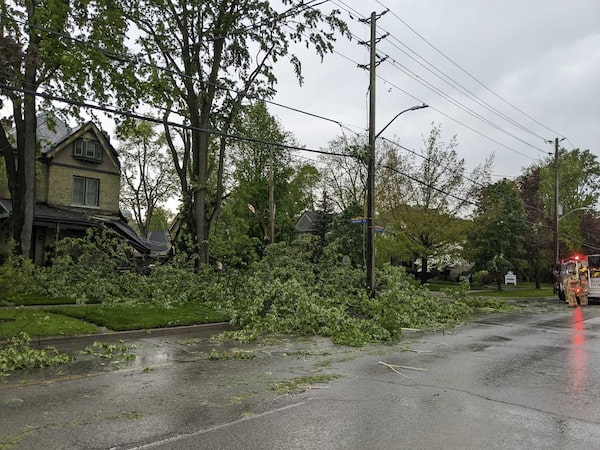Utility workers work to ensure the power is off as motorists remain in their vehicles after a major storm took down poles and power lines on Merivale Road in Ottawa, on Saturday, May 21, 2022.Justin Tang/The Canadian Press
At least five people are dead after a severe thunderstorm swept through southern and eastern Ontario and parts of Quebec on Saturday, downing trees and power lines and leaving hundreds of thousands without power.
Peel Regional Police said a woman in Brampton, Ont., was struck by a large tree as she walked during the storm. Investigators said she was rushed to hospital where she died of her injuries.
Later in the afternoon, Ontario Provincial Police reported that one person was killed and two others were injured when a tree fell onto a camping trailer in a conservation area between Brantford, Ont., and Kitchener, Ont. They also said a 44-year-old man was killed in Greater Madawaska, west of Ottawa, after reportedly being struck by a falling tree.
Ottawa Police said late Saturday that one person died in the city’s west end, but they didn’t release any further details. And in Gatineau, Que., police reported the death of a 51-year-old woman whose boat capsized in the Ottawa River, according to Radio-Canada.
Environment Canada issued the emergency alert at 12:45 p.m. on Saturday afternoon, warning people in the Greater Toronto Area to take cover if they saw inclement weather headed toward them. The agency said the storm was “very dangerous” and could produce toonie-sized hail.
“This is a dangerous and potentially life-threatening situation,” read a statement from the agency.
“Large hail can damage property and cause injury. Widespread and extremely strong wind gusts can destroy buildings with tornado-like damage, flatten large stands of trees and blow vehicles off the road.”
The agency advised drivers to slow down and be prepared to stop if visibility drops, and told people to take cover immediately if inclement weather approached them.
London, Ont., resident Nicole Fice described a chaotic scene in her neighbourhood, after the storm led to trees falling on her neighbours’ porch and cars, with one tree catching fire on her street after hitting a power line.
“There was debris everywhere,” said Ms. Fice, who said bricks from a neighbour’s home were strewn on her lawn after the storm.
She eventually left her home to make sure her neighbours were okay, and said people who had been on walks when the storm hit were running to their homes.
Omg a tree came down on my neighbour's house #ldnont #ONStorm pic.twitter.com/7YEA22COgA
— nicole fice (@n_lea_f) May 21, 2022
In Toronto’s west end, police reported a subway train became stuck after running over a downed tree. The service said passengers on the train were evacuated through tunnels as a result. The subway line was cleared hours later.
Meanwhile, Hydro One said more than 340,000 customers stretching from Sarnia, Ont., eastward past Toronto were without power.
Environment Canada later issued warnings further east in the province, including in Ottawa, where it said the storm was moving and producing similar damage. The agency ended the weather warnings later in the afternoon.

Nicole Fice says debris was everywhere in her London, Ont., neighbourhood, pictured in the aftermath of the severe thunderstorm that hit southern Ontario on May 21, 2022.Nicole Fice/Handout
Ottawa police said they were receiving reports of multiple injuries from the storm, and responders were attending calls for downed power lines and trees.
Joseph Muglia, director of Hydro Ottawa, said more than 179,000, or about half their customers, across the city had lost power.
“It’s still early in trying to try to establish what exactly what we’re dealing with here. We’re probably dealing with a multi-day event,” he said.
Kim Ayotte, general manager of Ottawa’s Emergency and Protective Services, said he expected the storm cleanup to take several days. “Crews are working as fast as they can and as safely as they can,” he said at a news conference.
The storm later made its way to Quebec, knocking down trees and hydro poles.
Hydro Quebec’s website showed about 357,000 customers without electricity as of 6 p.m., mainly in the Outaouais region in Western Quebec and the Laurentians area north of Montreal. Residents in Lanaudiere, northeast of Montreal, were also affected.
Environment Canada meteorologist Gerald Cheng said the winds of 132 kilometres per hour measured at the Kitchener, Ont., airport were enough of a risk to property and life to trigger an alert warning to people’s cellphones.
Mr. Cheng said the storm was unique because of the high speed of the winds.
“We don’t always see winds reaching over 130 kilometres an hour... that was quite extraordinary,” said Mr. Cheng, who added that while tornados are top of mind during such storms, people should be aware of the damage that wind gusts can do.
He said the weather pattern that created the conditions for the storm in Ontario were the same as the one that led to a deadly tornado in northern Michigan on Friday.
At least two people were killed and more than 40 were injured when a tornado touched down in the town of Gaylord, Mich., – an area where tornados are rarely seen. The storm created gusts of up to 225 kilometres an hour, and was powerful enough to throw cars on top of each other and collapse the roofs of several businesses. One person was still unaccounted for in the small community of 4,300 people.
Environment Canada warned that tornadoes were also a possibility in some parts of Ontario during the storm, but Mr. Cheng said there was no conclusive evidence to suggest that any had happened as of Saturday afternoon.
With files from The Canadian Press and Associated Press
Our Morning Update and Evening Update newsletters are written by Globe editors, giving you a concise summary of the day’s most important headlines. Sign up today.
 Salmaan Farooqui
Salmaan Farooqui